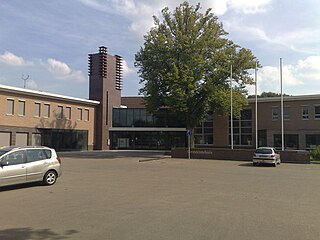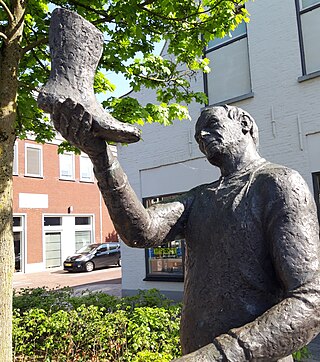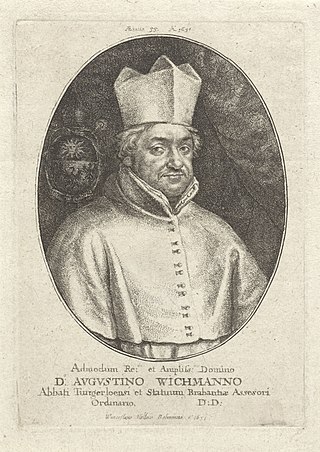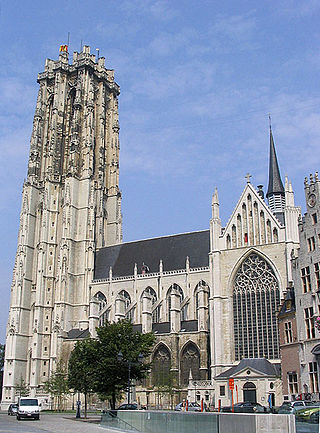Brabant is a traditional geographical region in the Low Countries of Europe. It may refer to:

's-Hertogenbosch, French: Bois-le-Duc, ; German: Herzogenbusch, colloquially known as Den Bosch, is a city and municipality in the Netherlands with a population of 157,486. It is the capital of the province of North Brabant and its fourth largest by population. The city is south of the Maas river and near the Waal.

North Brabant, also unofficially called Brabant, is a province in the south of the Netherlands. It borders the provinces of South Holland and Gelderland to the north, Limburg to the east, Zeeland to the west, and the Flemish provinces of Antwerp and Limburg to the south. The northern border follows the Meuse westward to its mouth in the Hollands Diep strait, part of the Rhine–Meuse–Scheldt delta. North Brabant had a population of about 2,626,000 as of January 2023. Major cities in North Brabant are Eindhoven, Tilburg, Breda, its provincial capital 's-Hertogenbosch, and Helmond

Veghel is a town and a former municipality in the southern Netherlands. On 1 January 2017 Veghel, together with Schijndel and Sint-Oedenrode, merged into a new municipality called Meierijstad creating the largest municipality of the province North-Brabant in terms of land area.

Eersel is a municipality and a town in southern Netherlands in the province of North Brabant. Eersel is situated in the Campine (Kempen) area.

Kortenberg is a Belgian municipality located in the province of Flemish Brabant, about halfway between the cities of Brussels and Leuven. The municipality comprises the subdivisions or deelgemeenten of Erps-Kwerps, Everberg, Kortenberg proper and Meerbeek. On 1 January 2013 Kortenberg had a total population of 19,393. The total area is 34.52 km2 which gives a population density of about 562 inhabitants per km2. In the southern part of Everberg there is also a hamlet called Vrebos, while between Erps-Kwerps and Meerbeek there is another hamlet called Schoonaarde, which can be found in the proximity of the train station of Erps-Kwerps.

Brabantian or Brabantish, also Brabantic or Brabantine, is a dialect group of the Dutch language. It is named after the historical Duchy of Brabant, which corresponded mainly to the Dutch province of North Brabant, the Belgian provinces of Antwerp and Flemish Brabant as well as the Brussels-Capital Region and the province of Walloon Brabant. Brabantian expands into small parts in the west of Limburg, and its strong influence on the Flemish dialects in East Flanders weakens toward the west. In a small area in the northwest of North Brabant (Willemstad), Hollandic is spoken. Conventionally, the Kleverlandish dialects are distinguished from Brabantian, but for no reason other than geography.
The States of Brabant were the representation of the three estates to the court of the Duke of Brabant. The three estates were also called the States. Supported by the economic strength of the cities Antwerp, Brussels and Leuven, the States always were an important power before the rulers of the country, as was reflected by the charter of the duchy.

The Duchy of Brabant, a state of the Holy Roman Empire, was established in 1183. It developed from the Landgraviate of Brabant of 1085–1183, and formed the heart of the historic Low Countries. The Duchy comprised part of the Burgundian Netherlands from 1430 and of the Habsburg Netherlands from 1482, until it was partitioned after the Dutch revolt of 1566–1648.

Paul Kempeneers is a Belgian philologist and linguist.

Kaatsheuvel is a town in the province of North Brabant, Netherlands situated along highways N261 and N628. With a population of roughly 16,600, it is the largest town in and the capital of the municipality of Loon op Zand, which also consists of the villages of De Moer and Loon op Zand.
Dutch dialects are primarily the dialects that are both cognate with the Dutch language and spoken in the same language area as the Dutch standard language. They are remarkably diverse and are found within Europe mainly in the Netherlands and northern Belgium.

Brecht Abbey, also known as the Abbey of Our Lady of Nazareth, is an abbey of Trappistine nuns located in Brecht, in the Campine region of the province of Antwerp. Life in the abbey is characterized by prayer, reading and manual work, the three basic elements of Trappist life.

Francis Wichmans (1596–1661), in religion Augustinus, was a Premonstratensian spiritual author, missionary, and abbot of Tongerlo Abbey. In the last capacity he sat in the First Estate of the States of Brabant.

The Joyous Entry of 1356 is the charter of liberties granted to the burghers of the Duchy of Brabant by the newly-ascended Duchess Joanna and her husband Duke Wenceslaus. The document is dated 3 January 1356, (NS) and it is seen as the equivalent of Magna Carta for the Low Countries.

Brabantine Gothic, occasionally called Brabantian Gothic, is a significant variant of Gothic architecture that is typical for the Low Countries. It surfaced in the first half of the 14th century at St. Rumbold's Cathedral in the city of Mechelen.

The War of the Brabantian Succession was a war of succession triggered by the death of John III, Duke of Brabant. He had no sons, and as the Duchy of Brabant had a tradition of male (agnatic) primogeniture, his three daughters and their three husbands, namely the dukes of Luxemburg and Guelders and the count of Flanders, claimed the inheritance.

The Sack of Lier, also known as the Fury of Lier in the Southern Netherlands, took place on 14 October 1595 when a force of the Dutch States Army led by Charles de Heraugières, governor of Breda, took the town by surprise during the Eighty Years' War. Heraugières, who was known for his daring surprise attacks over Breda in 1590 and Huy in March 1595, had been instructed to capture Lier ahead a small elite force while the bulk of the Spanish Army of Flanders was deployed in northern France and the Lower Rhine. The possession of Lier would have provided the Dutch Republic an advanced base deep inside the Brabant, which would allowed the States troops to cut the communications between Antwerp, Mechelen, Leuven and 's-Hertogenbosch, and to raid as far as Brussels.

The period between the Pacification of Ghent, and the Unions of Arras and Utrecht constituted a crucial phase of the Eighty Years' War between the Spanish Empire and the rebelling United Provinces, which would become the independent Dutch Republic. Sometimes known as the "general revolt", the period marked the only time of the war where the States–General of all Seventeen Provinces of the Habsburg Netherlands, except Luxemburg, were in joint active political and military rebellion against the Spanish Imperial government through the Pacification of Ghent. The Pacification formulated several agreements amongst the rebellious provinces themselves, and laid down their demands – including the immediate withdrawal of foreign troops from the Netherlands, restitution of old rights and privileges, and self-rule – to king Philip II of Spain.
















